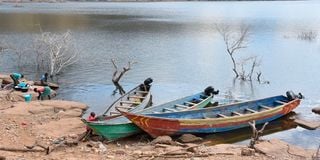Happening Now: LIVE: Agriculture CS Mithika Linturi's impeachment trial
Conservation efforts chart a path to save Turkwel Dam

Boats for fishermen parked at Turkwel Dam in West Pokot County on December 15, 2021. Fish in the dam has declined and there are plans to ban fishing for six months for the numbers to rejuvenate.
JARED NYATAYA (Eldoret).
What you need to know:
- The Suam River Basin, the primary water source for the Sh6 billion Turkwel hydropower and multi-purpose project in West Pokot, is facing the threat of extinction due to heavy siltation.
- Environmentalists and government agencies have launched multi-sectoral programmes to protect the basin
The Suam River Basin, the primary water source for the Sh6 billion Turkwel hydropower and multi-purpose project in West Pokot, is facing the threat of extinction due to heavy siltation, caused by environmental degradation. In response, environmentalists and government agencies have launched multi-sectoral programmes to protect the basin. They have initiated afforestation programmes to reclaim the degraded Mt Elgon forest, one of the country's five water towers and the primary source of the Suam River that drains into River Turkwel.
The programme also involves conserving the upper Suam water catchment area, threatened by unsustainable land use resulting in massive soil erosion and heavy siltation of the Suam River Basin. The Kerio Valley Development Authority (KVDA) is leading the program and working together with the Kenya Forest Service (KFS), Kenya Forest Research Institute (KEFRI), and Kenya Water Towers Agency (KWTA).
“The initiative is aimed at containing rampant land degradation caused by dwindling vegetation cover, soil erosion due to unsustainable land use, and declining water volume threatening the survival of Suam River and the Turkwel dam,” says Sammy Naporos, KVDA Managing Director.
Currently, the river is buried in 30,000 cubic metres of silt, affecting the water volumes and the ability to produce adequate power.
“As a government agency, we are involved in the conservation of the upper Suam River by distributing tree seedlings to learning institutions, community forest associations and the general community to contain soil erosion and siltation of the dam,” explained Mr Naporos.
The European Union (EU) and the national government have also launched a Sh42 million project to rehabilitate Mt Elgon and Cherangany water towers to mitigate climate change.
The Kenya Forest Research Institute (KEFRI) coordinates the programme and covers Uasin Gishu, Elgeyo Marakwet, West Pokot, and Trans-Nzoia counties. According to a report by a KEFRI, local communities will be involved in the conservation efforts.
“The public is being sensitised on diversifying trees and farming methods, helping farmers to plant trees and assist in conservation efforts and environment protection,” said Mr Anthony Musyoka, the KFS North Rift Head of Conservancy.
He discloses that 300 hectares of Sabor and Cheptongei forest in Elgeyo Marakwet County and 800 hectares of farmland have been planted with indigenous and exotic trees to conserve the country’s water towers.
Through the National Environment Trust Fund (Net fund), the Italian government has allocated Sh596 million( four million euros)to restore the degraded Cherangany water tower in Trans Nzoia, West Pokot and Elgeyo Marakwet counties.
The Cherangany ecosystem, one of the five water towers in the country, is the primary water catchment area for Lake Victoria and Turkana basin but is facing threat from settlers who have encroached the Embobut water catchment area.
The ecosystem is also the water source for Nzoia, Turkwel, and Kerio rivers but is severely threatened due to unchecked human activities.
“The big risk of economic activities and projects set on the foothills of Cherangany is catastrophes such as floods, landslides when it rains, and drought in the dry season because of the unabated environmental degradation on the watershed. Already, we have embarked on different restoration projects in agro-forestation on the riverbanks,” said the Italian Agency for Development Cooperation Team Leader for Agriculture, Luigi Luminari.
According to the Kenya Water Towers Agency’s (KWTA) policy brief, from1990-2016, 13,003 hectare of forest cover was lost in the Cherangany ecosystem, equivalent to an annual loss of 500 hectare.
KWTA reported that encroachment for agriculture and settlement, uncontrolled exploitation of endangered tree species, political interference, understaffing, limited financial resources, and inadequate infrastructure are among the threats to the Cherangany Hills water tower.
“The integrated master plan for the Cherang’any forest will involve the restoration of 200 hectares of forest and protection of the water tower that is key to the economic and social well-being of many Kenyans,” said Mr Musyoka.
The country’s five “water towers”—Mau Forest Complex, Mt. Kenya, Aberdares, Cherangany Hills, and Mt. Elgon—provides up to 75 per cent of the country’s water resources.
The destruction of the ecosystem forests and catchment areas has contributed to the growing water crisis and the impact of climate change in the country.
According to government reports, deforestation cost the country Sh 5.8 billion annually, which amounts to about 2 per cent of the Gross Domestic Product. Forestry resources contribute about 3 per cent to the economy.





